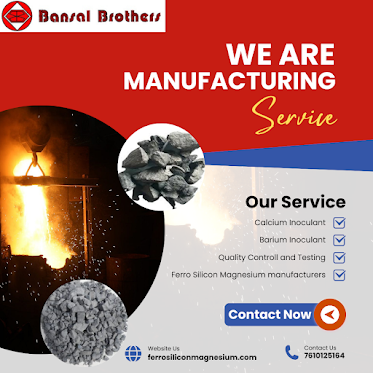Troubleshooting Common Foundry Issues with Nodularisers and Inoculants!
Foundries play a crucial role in producing high-quality cast iron and steel components for industries ranging from automotive to construction. Despite careful planning, many foundries encounter challenges that affect casting quality, such as porosity, shrinkage, inconsistent graphite formation, or weak mechanical properties. Fortunately, a significant number of these issues can be effectively addressed with the correct use of nodularisers and inoculants. Understanding how to troubleshoot these problems can save time, reduce wastage, and improve overall production efficiency.
Understanding Nodularisers and Inoculants
Before exploring troubleshooting strategies, it’s important to understand the role of nodularisers and inoculants in the casting process. Nodularisers are used to convert grey cast iron into ductile (spheroidal) iron by promoting the formation of spherical graphite. This transformation improves mechanical properties, including tensile strength, elongation, and impact resistance.
Inoculants, such as barium inoculants, calcium inoculants, or cerium inoculants, are added to molten iron to refine its microstructure. They promote uniform graphite nucleation, prevent carbide formation, and reduce common defects such as shrinkage cavities and gas porosity. When combined with appropriate ferro silicon magnesium, these additives ensure higher consistency, better machinability, and improved overall quality of cast components.
Common Foundry Issues and Their Causes
Foundries often face defects during casting that can compromise both strength and appearance. Common issues include:
Porosity – Small holes or voids within the casting caused by trapped gases or shrinkage.
Shrinkage Defects – Cavities formed as molten iron cools and contracts.
Inconsistent Graphite Formation – Irregular graphite distribution leading to weak or brittle castings.
Hard Spots and Carbide Formation – Areas with excessive carbides causing brittleness.
Surface Blowholes or Pinholes – Gases trapped during solidification causing surface imperfections.
Many of these problems stem from improper handling, timing, or quality of nodularisers and inoculants, as well as variations in furnace temperature and pouring techniques.
Troubleshooting Porosity Issues
Porosity is one of the most common casting defects. Using the right nodulariser can significantly reduce this issue. Insufficient or low-quality nodularisers may prevent proper spheroidal graphite formation, leading to gas pockets. Ensure nodularisers are added at the correct temperature, usually just before pouring, and in recommended quantities.
Inoculants play a complementary role. For example, adding barium inoculants or calcium inoculants can promote uniform graphite nucleation and reduce trapped gases. If porosity persists, evaluate furnace parameters, melt temperature, and pouring speed, as these factors directly affect gas solubility and escape.
Addressing Shrinkage Defects
Shrinkage cavities typically occur when molten iron cools unevenly. Proper inoculation with additives like cerium inoculants can refine the microstructure and promote uniform solidification, reducing shrinkage. For ductile iron, using a high-quality nodulariser combined with ferro silicon magnesium ensures maximum spheroidal graphite formation.
Troubleshooting shrinkage involves reviewing both chemical composition and the timing of additive additions. Overheating or under-dosing inoculants can exacerbate defects, so process control is essential for consistent results.
Solving Inconsistent Graphite Formation
Graphite morphology significantly affects mechanical performance. Irregular or flaky graphite can create weak spots in castings. This often happens due to improper handling of nodularisers or low-activity inoculants.
To troubleshoot, verify the quality of both nodularisers and inoculants, maintain proper melt temperature, and ensure thorough mixing. Consistent stirring and timely addition of barium, calcium, or cerium inoculants encourage uniform graphite nucleation, resulting in castings with desired ductility and strength.
Preventing Hard Spots and Carbides
Hard spots arise from local overheating, rapid cooling, or insufficient inoculation. These areas contain excessive carbides, making castings brittle and prone to cracking. High-quality inoculants and nodularisers reduce carbide formation and promote spheroidal graphite.
Regular testing of melt chemistry and microstructure helps detect and correct these issues early. Proper use of ferro silicon magnesium also ensures better graphite spheroidization and overall metallurgical performance.
Minimizing Surface Blowholes and Pinholes
Surface defects like blowholes or pinholes usually stem from trapped gases. Proper inoculation helps control gas release during solidification. Ensuring the melt is clean and free from contaminants, along with correct nodulariser use, minimizes surface imperfections. Pouring at appropriate speeds and temperatures further reduces gas entrapment, resulting in smoother, defect-free surfaces.
Best Practices for Using Nodularisers and Inoculants
Follow Manufacturer Guidelines: Use nodularisers and inoculants in the recommended quantities and temperature ranges.
Monitor Melt Temperature: Both underheating and overheating can reduce additive effectiveness.
Use High-Quality Additives: Opt for reliable nodularisers and barium, calcium, or cerium inoculants for consistent results.
Time Additions Properly: Nodularisers should be added just before pouring, while inoculants are added during melt preparation.
Ensure Thorough Mixing: Uniform distribution ensures optimal graphite formation and reduces defects.
Regular Testing: Analyze microstructure and mechanical properties regularly to identify potential issues early.
Conclusion
Foundries can overcome common casting defects such as porosity, shrinkage, inconsistent graphite, hard spots, and surface blowholes through proper use of nodularisers and inoculants. Additives like barium, calcium, and cerium inoculants, along with ferro silicon magnesium, help refine the microstructure, promote uniform graphite formation, and improve mechanical properties.
By focusing on additive quality, proper timing, and consistent melt control, foundry operators can reduce production losses, enhance efficiency, and deliver superior castings. Correct use of these materials not only resolves defects but also ensures long-term reliability, higher yield, and overall excellence in foundry operations.



Comments
Post a Comment